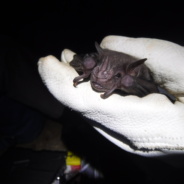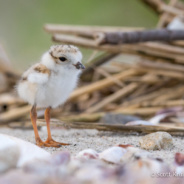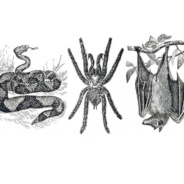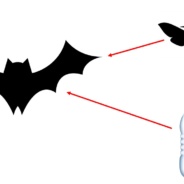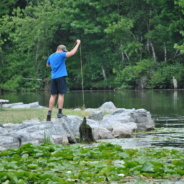I love this time of year. After the exuberance of summer and the vibrant colors of fall, I’m thankful for the days growing shorter. The nights longer. Temperatures falling. Silhouettes of bare branches against a leaden sky promising snow. All of nature winding down. Encouraging quiet. Reflection. Introspection. [more]
Chiropterophily: The incredible pollination services that bats provide.
Recently, many have become aware of the issues that our pollinating insects face. Insects have been in a general decline for some time now, which is worrisome as they help prop up the food chains that support just about everything else on the planet. There are over 400 species of native bees just in New York State alone, each with an important role in the food web. Other critters – flies, beetles, butterflies, birds, etc. are important pollinators as well. A critical pollinator that often gets overlooked is the majestic and glorious bat....
read moreVigilant volunteers on Connecticut beaches result in successful nesting season for threatened shorebirds.
Season recap reveals new details about where American Oystercatchers migrate, and historically low numbers for Least Terns. November 19, 2019– Thanks to the efforts of almost 100 volunteers on Connecticut’s beaches, two of the state’s most vulnerable shorebirds had highly successful breeding seasons in 2019, reflecting a generally safer shoreline locally for federally and state-threatened birds. The Audubon Alliance for Coastal Waterbirds announced that the 57 pairs of Piping Plovers that nested in the state fledged 1.72 chicks per...
read moreRTPI to Host Holiday Open House December 7th
RTPI will hold their annual Holiday Open House on Saturday, December 7, from 10:00AM – 5:00PM. Visitors will enjoy free admission into our galleries, light refreshments, and a chance to win a gift bag filled with unique items from our museum store. This event is part of Swedish Market Day in Jamestown – Julmarknad, organized by the Scandinavian Studies Program at Jamestown Community College. RTPI’s is currently featuring the artwork of Guy Coheleach in their galleries. Guy Coheleach: Wildlife in Art includes over 40 original paintings by...
read moreThe Message of the Monarchs by Becky Nystrom
Nature and her creatures are suffering, and they’re calling for our help. The message of the monarchs (Danaus plexippus), a once widespread and iconic organism now threatened with extinction, is but one of many species in unprecedented decline, pleading for our attention and action. Monarchs have much to teach us, and the plight of this amazing and ancient organism is a warning to us all that an ecological Armageddon may be underway. The eastern monarch’s mind-boggling three thousand-mile multigenerational migration between Mexico and North...
read moreRTPI to host “Guy Coheleach: Wildlife in Art”
The Board of Trustees of the Roger Tory Peterson Institute is pleased to host Guy Coheleach’s acclaimed traveling exhibition for the fall and winter season, beginning Friday, October 11th. Featuring more than forty original works, the exhibition includes several new pieces created by the artist in the last five years. RTPI has previously hosted solo exhibitions of Coheleach’s work in 1997, 2003 and 2008. In the introduction to the book Guy Coheleach’s Animal Art, Roger Tory Peterson wrote, “Guy is perhaps the most versatile and, in a...
read moreRTPI to host: Snakes, Spiders, and Bats! Oh, My!
The Roger Tory Peterson Institute of Natural History invites you to join us for “Snakes, Spiders, and Bats! Oh, my!” on Friday, October 11th from 5:30-8:00 pm. The Buffalo Zoo’s education department will be on site from 5:30-6:30pm with their “Zoo Mobile” to introduce guests to an array snakes, bats and spiders, and from 6:30 to 8:00 three knowledgeable and passionate local biologists (Twan Leenders, Becky Nystrom, and Jonathan Townsend) will explore the causes and consequences of the common misconceptions surrounding these creatures that so...
read morePlastic Pollution Awareness and Action Events in Jamestown – September 27
Plastic Pollution has become one of the greatest issues of our time; we’ve all seen the heartbreaking images of seabirds entangled in six pack rings, beached whales with bellies full of debris, and that video of the sea turtle with a plastic straw stuck in its nostril! Feel like you need to get out and DO something to protect our great outdoors and environment? Let’s do something together! The third week of September marks the first-ever National Nature Cleanup Week! Join some of the Jamestown area’s environmental ambassadors for one or...
read moreRTPI Begins New Plastic Pollution Research Initiative
Plastics have been around in their current form for decades, and estimates suggest that more than 8 billion metric tons have been created since large-scale production of plastic started in the 1950s. The vast majority of plastic that has been created is still in existence today – resting in landfills or floating around the planet’s waterways as litter. Plastics do not biodegrade, they photodegrade. This means that they don’t readily break down into their constituent materials, they simply break down into smaller and smaller particles. This...
read moreUpdate: 35 Stories in Celebration of RTPI’s 35th Anniversary
Can you believe that it’s June already? 2019 – the year in which RTPI is celebrating its 35th Anniversary – is almost halfway over. And while we’ve already written many chapters in the story of this milestone year, we still have many more to compose! As you may recall, one way that we are celebrating RTPI’s 35th Anniversary is by sharing “35 Stories”; a collection of ideas, memories, experiences, and more, that make our journey together special. We thought that this would be a good time to provide an update on this initiative! So here...
read moreAn introduction to Chautauqua Lake’s Aquatic Invasive Plants
Many aquatic plants exist within Chautauqua Lake; its nutrient-rich sediments provide a fertile growing bed for vegetation. Some of these plants are native to our area and provide critical ecological and environmental benefits, while others were introduced from distant locales and have been wreaking havoc on the ecological function, recreational and economic value of Chautauqua Lake. Surprisingly, some of the most prevalent invasives have been with us for decades already, while a steady stream of nearby or newly arriving species poses...
read more



